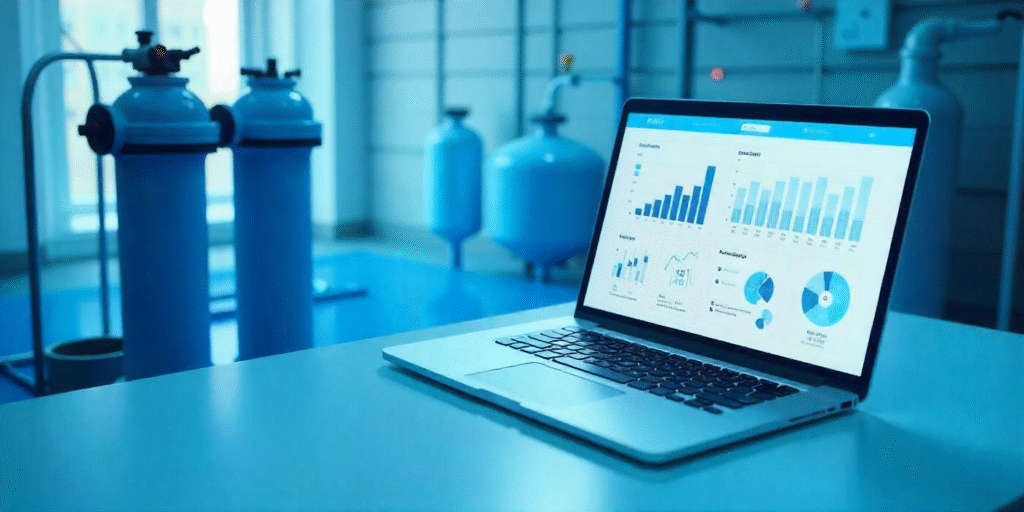When we started working on Genviss, one thing was clear: we weren’t dealing with a trendy product or a viral app. Genviss is a water treatment company. It offers industrial and domestic solutions like RO plants, softeners, STP, ETP, and AMC services. Not flashy, not mainstream. But necessary. And valuable.
We knew from the beginning that this project wasn’t going to be about overnight success or magic tricks. Instead, it would be about consistency, smart SEO, and understanding exactly what people are searching for when they look for water treatment services online.
This blog isn’t just a bragging post — it’s a real story of how our own company, Real Rank Riser, helped another one of our businesses slowly but surely build a name for itself online. If you run a service-based business and don’t know where to start with digital visibility, maybe this story will help.
Where Genviss Started
When we launched the Genviss website, it was a blank slate. Literally. A brand-new domain, no content, no backlinks, no local authority. For Google, it didn’t exist.
Our target audience was mainly industrial and domestic clients looking for water treatment plants in Gujarat — especially Ahmedabad and nearby cities. We were entering a space where local players had been around for years.
The Real Rank Riser Approach
We didn’t try to be everything all at once. Our first goal was simple: get indexed and start showing up.
Step 1: Technical Foundation
We started with:
- A clean, fast-loading website
- Basic mobile responsiveness
- Technical SEO audit to fix crawlability and indexation issues
This wasn’t complicated — it was just the minimum that needed to be done right. We used tools like Google Search Console to keep track of the basics.
Step 2: Local SEO Setup
Since our clients are mostly local (factories, offices, homeowners), we focused heavily on local SEO:
- Optimized the Google Business Profile
- Set up NAP consistency (Name, Address, Phone number) across local listings
- Embedded location-based keywords within the site: “ETP plant in Ahmedabad”, “RO plant AMC Gujarat”, etc.
We also created location pages with relevant, useful content rather than stuffing them with keywords.
Step 3: Keyword Mapping & Content
We didn’t aim for huge traffic. We aimed for relevant traffic.
We mapped service-based keywords that real customers might use — not SEO buzzwords. For example:
- “RO plant for factory”
- “ETP plant installation Gujarat”
- “Water softener for hard water at home”
We created individual service pages, blog posts, and FAQs. The content tone? Conversational, clear, and helpful. Not robotic.
Step 4: Backlinks
We didn’t go after 100s of spammy backlinks. Instead:
- We listed on industry-specific directories
- Participated in forums and Q&A discussions (like IndiaMart, Justdial)
- Got a few organic mentions by sharing useful guides on LinkedIn and Quora
This part was slow, but it kept us safe from penalties and helped build genuine authority.
What We Saw
Again, this wasn’t an overnight jump from 0 to viral. But within the first 5–6 months, here’s what we noticed:
- Indexed for 40+ targeted keywords
- Website traffic grew from nearly 0 to about 400–450 monthly organic visitors
- Google Business Profile started showing up in map packs for local queries
- Received 8–10 direct queries via contact form in the third month
- Closed 2 factory AMC deals — one from a blog, and another from a Google Maps listing
- Also received 2 enquiries from abroad — one from UAE, and another from Africa — looking for bulk RO plant supply
These numbers might look modest — but for a niche, industrial water treatment business? They’re right on point. Steady leads. Real interest.
What We Learned
Every industry has a digital space — even the “unsexy” ones. You don’t need to go viral to be found. You just need to:
- Understand your real audience
- Be consistent in your SEO basics
- Create useful, clear content
- Be patient
This project reinforced what we always tell our clients: it’s not about shiny dashboards or inflated vanity metrics. It’s about creating a digital footprint that actually gets you found when it matters.
Final Words
We didn’t just build a website. We built trust — one search, one click, and one lead at a time.
If you’re someone running a local business, and you want to grow digitally without burning cash on ads every month, we’d love to help.
And if you want to see how Genviss is doing now, feel free to check out the website:
→ https://genviss.in
Thanks for reading. Hope this gave you some clarity on what realistic SEO growth looks like.

